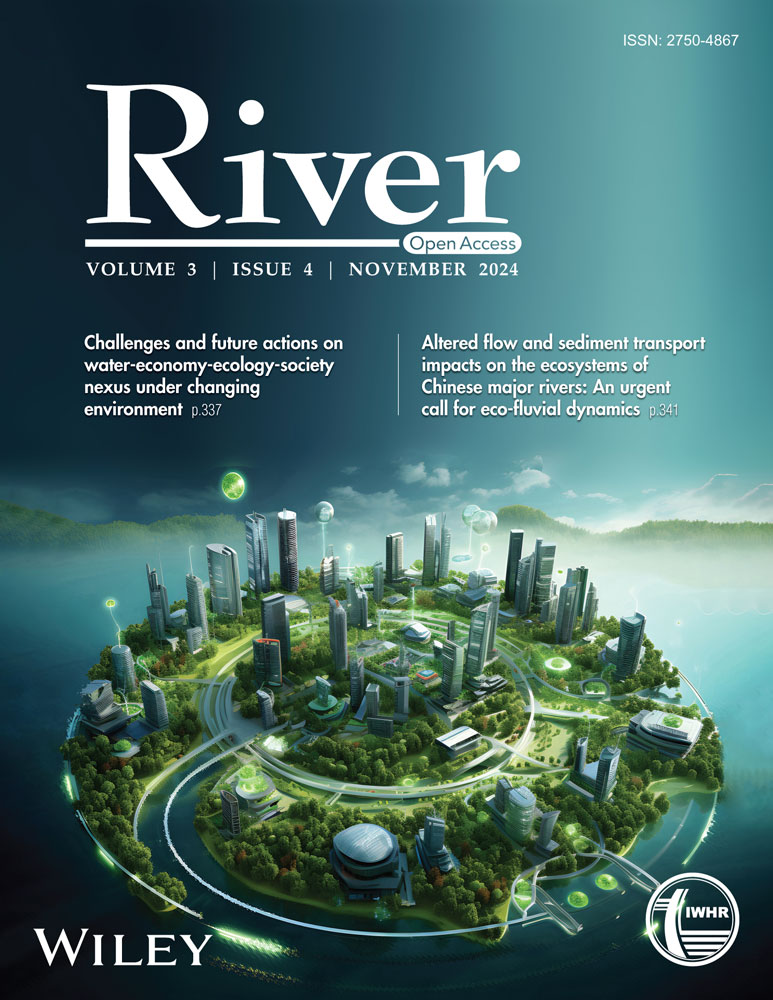Beyond natural flow: Human-directed course change of the Kolong river in Nagaon, Assam, (India) and its socio-ecological implications
Abstract
The Kolong, a significant distributary of the mighty river Brahmaputra in Assam, India, has experienced significant human-induced alterations aimed basically for flood mitigation. This study investigates the socio-ecological impacts of the course change of the Kolong River done by the local people of Kahargaon village in Nagaon district of Assam, India. Employing a mixed-methods approach, the research integrates field observations, stakeholder interviews, community forums, and secondary data analysis to assess the river's dynamics and its effects on local livelihoods and ecosystems. The findings reveal that while flood mitigation efforts have provided immediate relief, they have also led to ecological degradation and disrupted traditional livelihoods, particularly those dependent on the river's natural flow. The left-out channel, once rich in biodiversity, now suffers from reduced water levels and a diminished riverine ecological niche, compelling communities to adapt through alternative agricultural practices and grazing. This study emphasizes the need for integrated management strategies that balance flood control with ecological preservation and livelihood sustainability. Thus, the study promotes community-based conservation initiatives, restoring natural flow patterns, and developing adaptive livelihood strategies. The insights gained so far contribute to the broader understanding of human–river interactions and offer valuable lessons for sustainable river management in similar contexts globally.
1 INTRODUCTION
Rivers are dynamic systems and among the most influential surficial agents that shape landscapes (Rodriguez-Iturbe et al., 2009) and support diverse ecosystems (Arthington et al., 2010; Mili et al., 2023). In many cases, the natural meandering patterns of rivers play a crucial role in regulating flow (Ward et al., 2001), promoting biodiversity (Bhuyan & Deka, 2021), and providing essential resources for the livelihood sustainability of floodplain dwellers (Bhuyan, 2016). The meandering river reaches create habitats for various aquatic species and contribute to the ecological balance of surrounding areas (Garcia et al., 2012). However, human activities, such as agriculture, urbanization, and flood control measures, often alter these flows, leading to significant ecological and social consequences (Gregory, 2006; Wheater & Evans, 2009). Understanding the interplay between river dynamics and human intervention is vital for sustainable management of river systems (Bhuyan & Deka, 2024; Di Baldassarre et al., 2013), as these changes can impact water quality, habitat availability, and community livelihoods, ultimately influencing regional stability (Pradhan et al., 2021).
The Brahmaputra Valley in Assam, India, is characterized by its rich biodiversity, cultural heritage, and reliance on river systems (Bhuyan, 2018; Nath et al., 2024). However, the valley has recently faced challenges due to frequent flooding, which damages infrastructure and disrupts livelihoods (Bhattachaiyya & Bora, 1997; Bhuyan, Deka & Saikia, 2024; Dhar & Nandargi, 2000). The recurrent floods lead to the loss of crops, and displacing families from their homes, creating a cycle of vulnerability and economic hardship (Bhuyan, Pradhan, et al., 2022; Hazarika et al., 2016). Additionally, these floods can contaminate drinking water sources (Anik et al., 2023), posing significant health risks to the community (Connolly et al., 2022; Bhuyan & Deka, 2022; Tackley et al., 2023). The resulting socioeconomic stress underscores the urgent need for effective flood management strategies that can mitigate these impacts while maintaining ecological integrity (Bhattachaiyya & Bora, 1997; Robinson et al., 2023).
Despite existing literature on flood management and mitigation (Das, 2014; Kotoky et al., 2015; Pal et al., 2013; Sahu, 2007; Saikia, 2022) and flood risk assessment (Bhuyan et al., 2023; Gogoi et al., 2013; Sharma et al., 2012; Shivaprasad Sharma et al., 2018) in different parts of the Brahmaputra valley, there remains a significant gap in understanding the long-term ecological impacts of artificially altered river courses. Previous studies have largely focused on immediate flooding issues, management, and mitigation in different parts of the valley, and risk assessments without adequately addressing the consequences of engineering interventions on biodiversity, habitat degradation, and community well-being. This research seeks to bridge this gap by examining the socio-ecological ramifications of changes in the course of the river Kolong, integrating local perspectives on these transformations. The Kolong River, an anabranch of the Brahmaputra, has historically been an essential natural resource for local communities, providing water for drinking, agriculture, and fishing (Bhuyan, Borah, et al., 2022). Recent alterations to the Kolong's natural course, primarily aimed at flood mitigation, have raised concerns about riverine ecological health and community resilience. These interventions not only influence the river's fluvio-geomorphic character but also affect traditional practices and resource availability, highlighting the need for integrated management approaches that consider both ecological and socioeconomic factors. By assessing the implications of shifts in the river's course on aquatic life and the livelihoods of local communities, this study aims to provide a comprehensive understanding of the intertwined fates of humans and their surrounding environment. To achieve this, a mixed-methods approach was employed, incorporating field visits, stakeholder interviews, and community forums. Field visits facilitated direct observation of physical and ecological conditions, including changes in water levels and habitat quality. Stakeholder interviews provided insights from various community members, including farmers, fishermen, and local elders, capturing their experiences and perspectives on the river's changes. Community forums fostered wider discussions, ensuring that local voices are integral to action-oriented research and decision-making. Additionally, secondary data from government reports and academic literature provided further context for the findings, enabling a comprehensive analysis of the river's dynamics and their impact on the local community.
The primary objective of this study is to evaluate the ecological and socioeconomic impacts of the artificial alteration of the Kolong River's reach at Kahargaon, a village located in the southern floodplain of the Brahmaputra Valley, with a focus on how human interventions affect local livelihoods and ecosystems. The central research question this study seeks to address is: How can strategies be identified and implemented to balance flood mitigation with ecological preservation?
This study has practical implications for local communities by offering insights that can inform effective management strategies to mitigate flooding while preserving riverine ecological health. By incorporating community perspectives, the research aims to empower residents and enhance their resilience against environmental changes, ultimately leading to more sustainable livelihoods. Engaging local stakeholders ensures that management efforts align with the community's needs and values, fostering a sense of ownership and responsibility for the river's health. Globally, the findings of this study contribute to the understanding of human–river interactions, offering lessons for river systems facing similar pressures. By highlighting the importance of integrating ecological integrity with community needs, this research serves as a reference for policymakers and researchers seeking sustainable solutions in diverse contexts. The experiences and strategies derived from the Kolong River may inform practices in other regions grappling with the complexities of river management, ecological degradation, and community engagement.
2 CONDUCTING THE STUDY AND FINDING A WAY OUT
This study was conducted in Kahargaon village, Nagaon district, Assam, India (Figure 1), where the Kolong River, which once flowed along both its eastern and northern borders, now flows only along the northern border of the village. The Kolong River, a significant waterway in middle Assam, is known for its severe degradation and flow deficits (Bora & Goswami, 2022). Stretching approximately 212 km, the Kolong River diverges near Jakhalabandha, about 77 km upstream from Nagaon, and reconverges with the Brahmaputra at Kajalimukh, near Guwahati, forming a joint channel with the Kopili River. The Kopili, a major tributary on the south bank of the Brahmaputra, merges with the Kolong near Jagibhakatgaon in the Morigaon district of Assam. Flowing through the floodplains of Nagaon, Morigaon, and Kamrup districts in Assam, the Kolong River is fed by three primary tributaries: Misa, Dizu, and Haria.
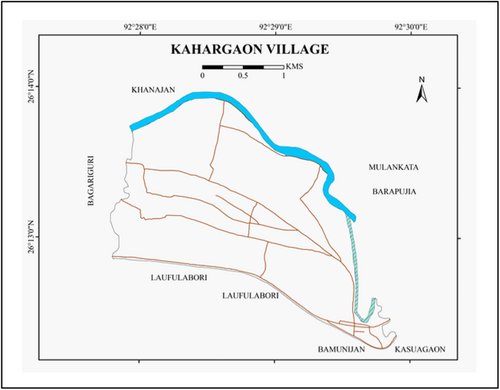
2.1 Identifying key issues
The process of identifying the key issues related to the alteration of the Kolong River's reach in Kahargaon village involved a comprehensive approach that combined direct observation, community engagement, and stakeholder input (Figure 2). We adopted a comprehensive sampling strategy that encompassed participants from a variety of demographics, including age, gender, occupation, and socioeconomic status. This approach was designed to ensure that the surveyed communities reflect the broader population impacted by the river's redirection. By including a diverse range of voices and experiences, we were able to enrich our understanding of the community's response to the river's alterations, thereby strengthening the validity of our findings on its socioeconomic effects. Field visits and surveys were essential in gathering detailed information about the river's current condition. By closely observing the changes in water levels, sedimentation patterns, and the conditions of the surrounding habitats, the present study helps identify several environmental impacts. These included increased sedimentation, which affected water quality and aquatic life, and alterations in the river's flow that contributed to habitat degradation. The physical characteristics observed during these visits provided a foundation for understanding how the river's ecology had been disrupted.
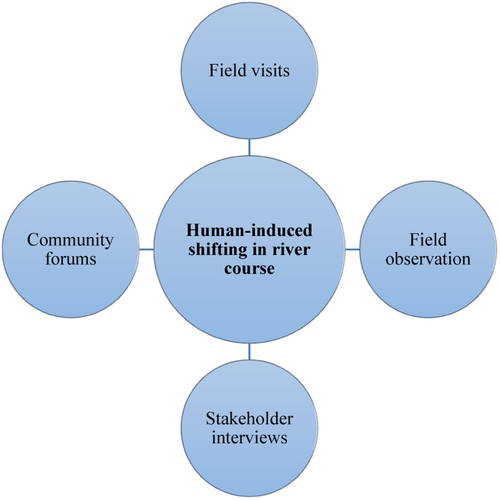
Stakeholder interviews played a crucial role in uncovering the socioeconomic impacts of the river's course change. Engaging with 14 farmers and 11 fishermen from diverse age groups, along with other community members, provided valuable insights into how these changes have affected their livelihoods and well-being. For instance, fishermen provided critical information on water level fluctuations, which were directly linked to their fishing practices and income. These interviews highlighted concerns such as reduced fish populations, decreased agricultural productivity due to altered irrigation patterns, and increased vulnerability to flooding. By capturing the experiences and knowledge of local stakeholders, the study was able to pinpoint the most pressing issues from a human perspective.
Community forums, with the active participation of 34 residents from diverse age-sex groups, occupations, and socioeconomic backgrounds, further enriched the understanding of key issues by fostering dialogue between residents and researchers. Their participation was voluntary, facilitated by the village head (gaon buha), who informed residents about the forum's purpose and encouraged them to share their perspectives. These sessions were conducted as unstructured interviews without a formal questionnaire, allowing participants to freely express their thoughts and contribute their own insights on the issues at hand. These forums served as a platform for participants to share their concerns, experiences, and suggestions for managing the river's challenges. The collaborative nature of these discussions helped identify not only the immediate impacts of the river's alteration but also the longer term challenges the community anticipated. Participants repeatedly emphasized issues such as the need for better flood management, the preservation of traditional livelihoods, and the protection of the river's ecological integrity. Through this multifaceted approach, the study identified several key issues, including environmental degradation, socioeconomic disruption, and the need for sustainable management practices. These findings were instrumental in shaping strategies aimed at mitigating the negative impacts of the river's altered course and ensuring the well-being of the affected communities.
3 HUMAN-DIRECTED COURSE CHANGE OF KOLONG AND ITS CAUSES
The Kolong River in Kahargaon village has undergone a significant transformation due to alterations in its natural meandering pattern. Originally, the river's winding course created natural loops that helped moderate its flow and maintain a dynamic riverine ecosystem (Bhuyan, 2024). However, these bends also made the area prone to flooding during heavy rains, causing substantial damage to agricultural lands, homes, and local infrastructure. The frequent summer flooding disrupted daily life and led to economic hardships for the villagers. In response to these ongoing challenges, local authorities, supported by the community, initiated a project in the early 1970s to straighten the river's course (Bhuyan, 2018). This engineering effort involved cutting through the river's meanders to create a more direct flow path, facilitating quicker water discharge (Figure 3). As a result, the flood risk in the village was significantly reduced. However, this modification created a portion of the river that became isolated from the main flow, known as Mora-Kolong (dead channel). Initially, the Mora-Kolong retained a steady water flow, evolving into a unique, ecologically rich habitat that became a sanctuary for various aquatic species and contributed positively to the local hydroecological balance.
Notably, the primary motivation for altering the Kolong's course was the urgent need to address the chronic flooding affecting the village. The river's natural meander reach created vulnerabilities where water overflowed during heavy rainfall, posing significant threats to the community's safety and economic stability. With recurrent floods damaging property and crops, the villagers recognized the need for immediate action. The collaboration between villagers and local authorities was crucial in planning and executing the river-straightening project. The community's active involvement ensured that the intervention met their needs while also benefiting from the technical expertise of local authorities. The decision to modify the river's course was driven by a collective desire for enhanced safety and a more stable economic environment.
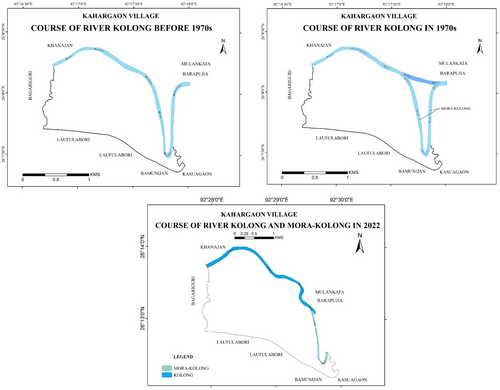
4 DUAL IMPACT OF RIVER COURSE MODIFICATION: ENVIRONMENTAL GAINS AND LOSSES
The change in the Kolong River's course has had both positive and negative implications for the environment and the local community. On the positive side, the primary benefit was a substantial reduction in flood risks, which improved the safety of the villagers and protected agricultural lands. This reduction allowed for more stable farming and production activities, enhancing the overall quality of life for the villagers. The slow-moving waters created ideal conditions for a diverse range of aquatic plants and animals, contributing to the area's overall biodiversity. This habitat previously supported local fishing practices, which were vital for food security and the livelihoods of the community.
However, over time, the ecological balance within the Mora-Kolong started deteriorating due to human activities. The construction of a road over the channel significantly altered its flow dynamics, leading to stagnation and a decline in ecological health (Figure 4). The disrupted connection between the Mora-Kolong and the primary Kolong River limited the flow of nutrients and sediments essential for supporting aquatic life and the livelihoods of local residents. As fish populations declined, the impact reverberated across the ecosystem, disrupting other species and key ecological processes. Fish-eating birds, such as cranes and kingfishers, experienced declines in their populations, disrupting the local food web (Bhuyan & Deka, 2024). Similarly, the decrease in toads and crabs threatened the snakes that prey on these species, leading to further ecological imbalances in the affected areas.
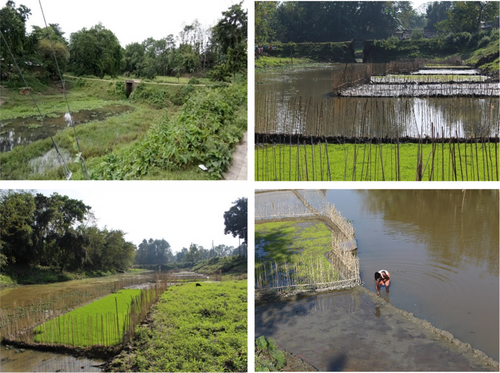
The proliferation of aquatic weeds in the channel, driven by reduced water flow, has introduced further challenges. Excessive plant growth has suffocated native species, further compromising the health of the aquatic environment and hindering fish farming efforts. This situation highlights the intricate interconnections between aquatic and terrestrial ecosystems, where changes in one realm can significantly affect the other. Moreover, many wetlands that once served as essential water storage areas have been filled or altered, resulting in habitat degradation for numerous species. While villagers have adapted by using the dry channel bed for agriculture, this practice has destabilized ecological functions and threatened the long-term sustainability of the local environment.
5 SHIFTING WATER DYNAMICS: COMMUNITY ADAPTATIONS TO RIVER COURSE ALTERATION
Before the construction of ring wells and tube wells, communities along the Kolong River relied heavily on natural water sources such as rivers and ponds. Historically, the Kolong was a perennial channel, boasting summer water levels that averaged around 51 feet before the 1970s (Bhuyan & Deka, 2024). For the residents living along its banks, the river was essential for daily activities such as drinking, bathing, washing, cooking, and farming. However, with the river's course artificially shifted, constant sedimentation at the mouths of the bends in the Mora-Kolong resulted in reduced water flow, which in turn caused a notable decline in water levels. By 2022, the water level had dropped to approximately 42.50 feet, highlighting the impact of both natural processes and human interventions on the river's health (Bhuyan, 2024).
In particular, the construction of a road over the Mora-Kolong exacerbated the situation. The road was designed with a culvert that allowed only a narrow passage for water, restricting its flow. As a result, the river began to dry up during the winter months, transforming it into a nearly barren landscape that was once a vital water source. Locals adapted to this change by repurposing the dry riverbed for agricultural use, creating seedbed, and cultivating various vegetables. This shift illustrates the resilience of the community but also underscores the adverse effects of sedimentation and human intervention on the river's ecological balance and flow pattern.
The elevation of the riverbed due to sediment buildup not only diminishes the river's depth but also affects its ability to support aquatic life. With reduced water levels and stagnant conditions, the ecological richness that once characterized the Kolong and its tributaries has significantly diminished. These ongoing changes highlight the need for sustainable management practices to restore the river's fluvio-geomorphic conditions and ensure the availability of water resources for both local communities and wildlife.
6 TOWARD SUSTAINABLE RIVER STEWARDSHIP: IMPLICATIONS AND RECOMMENDATIONS
The situation surrounding the Kolong River in Kahargaon highlights an urgent need for sustainable river management practices. While engineering solutions effectively addressed immediate flooding concerns, the long-term ecological consequences were often overlooked. This underscores the necessity for an integrated approach that balances human needs with environmental sustainability. To achieve this, regular monitoring of ecological and hydrological conditions is essential in the river for identifying emerging challenges and facilitating timely interventions. A comprehensive monitoring system can provide critical data on water quality, flow rates, and biodiversity, which are essential for understanding the river's hydroecological health.
Building on the need for monitoring, implementing adaptive management strategies is vital for aligning river management with community interests while ensuring ecological health (Williams & Brown, 2014). Policies should be flexible and evolve based on new scientific insights and community feedback, allowing for adjustments to changing environmental conditions. Engaging local stakeholders in decision-making processes will tailor management efforts to the unique needs of the community. Regular forums for dialogue between community members and authorities can foster collaboration (Innes & Booher, 2003) and empower residents to take an active role in the stewardship of their natural resources.
Thus, holistic river basin management approaches are essential to address immediate concerns while preserving ecological integrity for future generations. Recognizing the interconnectedness of aquatic and terrestrial ecosystems in the Kolong is crucial for promoting resilience and sustainability in the face of ongoing environmental changes. The replacement of the existing road over the Mora-Kolong River with a bridge is crucial for restoring the river's natural flow. This modification would allow water to flow freely through the currently stagnant channel, transforming it into a vibrant, flowing waterway. By re-establishing this flow, the river could rejuvenate its aquatic ecology, providing essential habitats for various species and enhancing biodiversity. Additionally, improved water movement would facilitate natural sediment transport processes, which are critical for maintaining river health. This strategic change would not only revitalize the ecosystem but also enhance water quality and resilience against flooding, ensuring the long-term sustainability of the Mora-Kolong River and its surrounding environment. Moreover, protecting wetlands and natural buffers along the riverbanks can enhance the ecosystem's ability to absorb floodwaters and filter pollutants (Suchara, 2019). Policy implications should include regulations to limit harmful practices while promoting conservation initiatives, ensuring that future generations are equipped to care for their environment.
7 CONCLUSION
The study of the human-directed course change of the Kolong River in Nagaon, Assam, reveals the intricate balance required between flood mitigation and ecological sustainability. The diversion of the river, aimed at reducing recurrent flooding, has led to significant ecological and socioeconomic impacts in Kahargaon village. This alteration has disrupted natural hydrology, reduced water flow in the original meandering path, degraded aquatic habitats, and changed sedimentation patterns. These disruptions have adversely affected soil quality and agricultural productivity, undermining the livelihoods of local farmers and fishermen. The straightened river channel, while addressing short-term flood risks, has not replicated the natural flood-mitigating properties of a meandering river, leaving the community vulnerable to future flooding events. Additionally, the loss of ecological richness in the left-out dead channel underscores the need for a balanced approach that considers both ecological preservation and flood management.
This research highlights the importance of integrating local community perspectives into river management strategies, emphasizing stakeholder engagement through surveys and community forums. These interactions provide valuable insights into socioeconomic impacts, facilitating a collaborative approach to identifying sustainable solutions. The findings suggest that effective river management should aim to restore the ecological integrity of the Kolong River while ensuring the livelihood sustainability of the local people. Importantly, this study offers valuable lessons for addressing similar challenges faced globally, as many regions are currently experiencing the dual pressures of flooding and ecological degradation. By advocating for a holistic river management framework that balances flood mitigation with ecological preservation, policymakers and practitioners can adopt adaptive strategies that prioritize community input and ecological health. This research not only informs local management practices but also serves as a reference for other river systems worldwide, encouraging sustainable outcomes that harmonize human needs with environmental sustainability.
ETHICS STATEMENT
None declared.
CONSENT FOR PUBLICATION
The authors have nothing to report.
Open Research
DATA AVAILABILITY STATEMENT
Data sharing is not applicable to this article as no new data were created or analyzed in this study.



